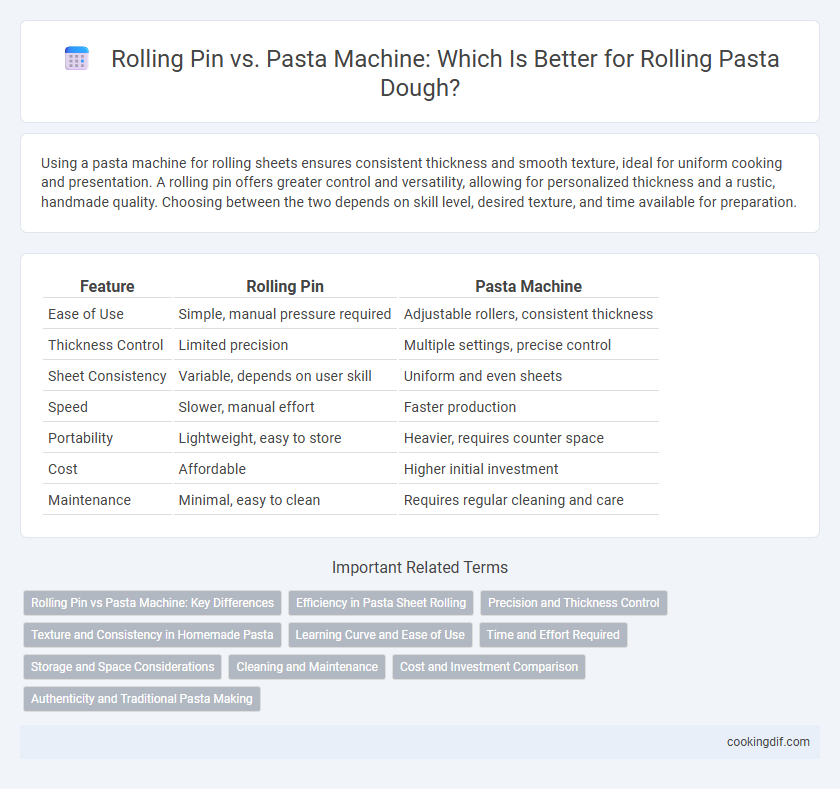Using a pasta machine for rolling sheets ensures consistent thickness and smooth texture, ideal for uniform cooking and presentation. A rolling pin offers greater control and versatility, allowing for personalized thickness and a rustic, handmade quality. Choosing between the two depends on skill level, desired texture, and time available for preparation.
Table of Comparison
| Feature | Rolling Pin | Pasta Machine |
|---|---|---|
| Ease of Use | Simple, manual pressure required | Adjustable rollers, consistent thickness |
| Thickness Control | Limited precision | Multiple settings, precise control |
| Sheet Consistency | Variable, depends on user skill | Uniform and even sheets |
| Speed | Slower, manual effort | Faster production |
| Portability | Lightweight, easy to store | Heavier, requires counter space |
| Cost | Affordable | Higher initial investment |
| Maintenance | Minimal, easy to clean | Requires regular cleaning and care |
Rolling Pin vs Pasta Machine: Key Differences
A rolling pin offers traditional control and flexibility for shaping pasta dough, enabling handmade textures with variable thickness based on pressure. In contrast, a pasta machine ensures uniform sheet thickness and faster, consistent results through adjustable settings and mechanical rollers. Choosing between a rolling pin and pasta machine depends on desired precision, convenience, and authenticity in pasta preparation.
Efficiency in Pasta Sheet Rolling
A pasta machine offers superior efficiency in pasta sheet rolling by providing consistent thickness and smooth texture through adjustable rollers, significantly reducing manual effort compared to a rolling pin. The rolling pin requires repetitive hand-rolling, which can be time-consuming and may result in uneven sheets, impacting the quality of the pasta. For large batches or precise thickness control, a pasta machine streamlines the process and enhances productivity in pasta preparation.
Precision and Thickness Control
Using a pasta machine offers superior precision and consistent thickness control compared to a rolling pin, ensuring uniform pasta sheets ideal for recipes like lasagna and ravioli. Pasta machines allow adjustable settings for exact sheet thickness, reducing manual effort and variability. Rolling pins require skill and practice to achieve even thickness, often resulting in less consistent pasta textures.
Texture and Consistency in Homemade Pasta
A pasta machine ensures uniform thickness and smooth texture by exerting consistent pressure across the dough, resulting in even cooking and a professional finish. A rolling pin offers greater control over dough thickness variations but may lead to uneven textures and less consistent results. For achieving balanced texture and consistent sheet thickness in homemade pasta, a pasta machine is generally preferred.
Learning Curve and Ease of Use
A rolling pin offers a straightforward learning curve and greater control for shaping pasta sheets but requires more physical effort and practice to achieve uniform thickness. Pasta machines simplify the process with adjustable rollers that ensure consistent sheet thickness and faster results, making them ideal for beginners. Mastery of a rolling pin demands patience and skill development, whereas a pasta machine enhances ease of use and efficiency in homemade pasta preparation.
Time and Effort Required
A pasta machine significantly reduces the time and effort required to roll out sheets compared to a rolling pin, allowing for consistent thickness with minimal physical strain. While a rolling pin demands manual skill and repetitive motion, often leading to uneven dough, a pasta machine streamlines the process with adjustable settings for precision. For frequent pasta makers, investing in a pasta machine enhances efficiency and produces higher-quality sheets faster.
Storage and Space Considerations
A rolling pin offers compact storage and requires minimal kitchen space, making it ideal for small countertops and easy accessibility. Pasta machines, while bulkier and needing dedicated storage space, often come with foldable or detachable parts to optimize space efficiency. Choosing between the two depends on available kitchen space and frequency of pasta sheet preparation.
Cleaning and Maintenance
A rolling pin requires simple cleaning by wiping with a dry cloth and occasional light flouring to prevent sticking, making maintenance straightforward and minimal. Pasta machines demand thorough cleaning to remove dough residues from rollers and cutters, often necessitating a brush or wooden stick, since water can cause rust and damage. Proper and regular maintenance of pasta machines ensures smooth operation and longevity, while rolling pins offer a more resilient and low-maintenance alternative.
Cost and Investment Comparison
Rolling pins offer an affordable, low-cost option for pasta sheet rolling, making them ideal for occasional home use with minimal investment. Pasta machines involve a higher initial expense but provide consistent thickness and ease of use, justifying the cost for frequent pasta makers or small-scale producers. Evaluating long-term benefits and usage frequency is crucial in determining the best investment between manual rolling pins and mechanical pasta machines.
Authenticity and Traditional Pasta Making
A rolling pin preserves the tactile connection and control essential to authentic, traditional pasta making, allowing artisans to adjust thickness based on feel and experience. Pasta machines offer uniformity and speed but may lack the nuanced texture achieved through hand-rolling, which many purists believe defines genuine Italian pasta sheets. For those prioritizing heritage and craftsmanship, the rolling pin remains the preferred tool for producing traditional pasta dough sheets.
Rolling pin vs pasta machine for sheet rolling Infographic

 cookingdif.com
cookingdif.com